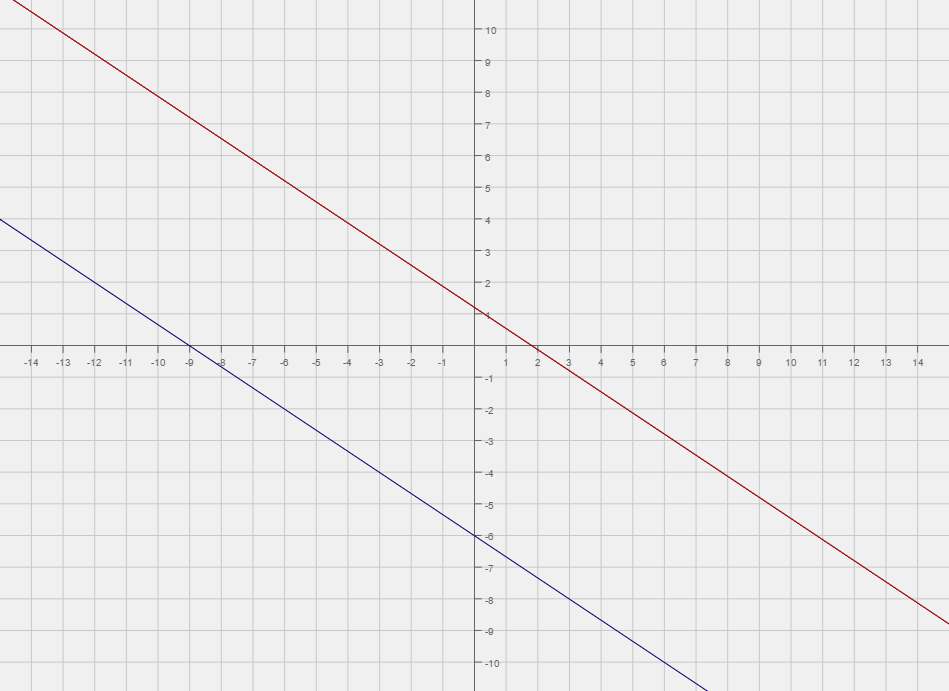A calculus problem by Rocco Dalto

The graph of are two parallel lines.
If one line is represented by and the other line is represented by where
Find:
The answer is 23.
This section requires Javascript.
You are seeing this because something didn't load right. We suggest you, (a) try
refreshing the page, (b) enabling javascript if it is disabled on your browser and,
finally, (c)
loading the
non-javascript version of this page
. We're sorry about the hassle.
Using the equations of rotation to rotate the x and y axis we have:
x = x ′ c o s θ − y ′ s i n θ
y = x ′ s i n θ + y ′ c o s θ
Replacing the equations of rotation in the original equation and simplifying we obtain:
( 4 c o s 2 θ + 1 2 c o s θ s i n θ + 9 s i n 2 θ ) x ′ 2 + ( 4 s i n 2 θ − 1 2 c o s θ s i n θ + 9 c o s 2 θ ) y ′ 2 +
( 1 2 1 3 s i n θ + 8 1 3 c o s θ ) x ′ + ( 1 2 1 3 c o s θ − 8 1 3 s i n θ ) y ′ + ( 5 s i n ( 2 θ ) + 1 2 c o s ( 2 θ ) ) x ′ y ′ − 6 5 = 0
To eliminate the x ′ y ′ term let 5 s i n ( 2 θ ) + 1 2 c o s ( 2 θ ) = 0 ⟹
t a n ( 2 θ ) = 5 − 1 2 ⟹ 1 − t a n 2 θ 2 t a n θ = 5 − 1 2 ⟹
6 t a n 2 θ − 5 t a n θ − 6 = 0 ⟹ t a n θ = 1 2 5 + − 1 3
Choosing the positive value for t a n θ ⟹ t a n θ = 2 3 ⟹ c o s θ = 1 3 2 a n d s i n θ = 1 3 3 ⟹
x = 1 3 2 x ′ − 1 3 3 y ′ a n d y = 1 3 3 x ′ + 1 3 2 y ′
Replacing the equations of rotation in the original equation and simplifying we obtain:
1 6 9 x ′ 2 + 6 7 6 x ′ − 8 4 5 = 0 ⟹ x ′ 2 + 4 x ′ − 5 = 0 ⟹ ( x ′ + 5 ) ( x ′ − 1 ) = 0
∴ we have two parallel lines x ′ = 1 a n d x ′ = − 5 in the x ′ y ′ plane.
To find parallel lines in the x y plane:
For x ′ = 1 :
y ′ = 0 ⟹ ( 1 3 2 , 1 3 3 )
y ′ = 1 ⟹ ( − 1 3 1 , 1 3 5 ) ⟹ s l o p e m = − 3 2 ⟹ y − 1 3 5 = − 3 2 ( x + 1 3 1 ) ⟹ − 2 1 3 x − 3 1 3 y + 1 3 = 0
and for x ′ = − 5 :
y ′ = 0 ⟹ ( − 1 3 1 0 , − 1 3 1 5 )
y ′ = 1 ⟹ ( − 1 3 1 3 , − 1 3 1 3 ) ⟹ s l o p e m = − 3 2 ⟹ − 2 x − 3 y − 5 1 3 = 0
∴ The two parallel lines in the x y plane are:
− 2 1 3 x − 3 1 3 y + 1 3 = 0
− 2 x − 3 y − 5 1 3 = 0
⟹ ∣ a ∣ + ∣ b ∣ + ∣ c ∣ + ∣ d ∣ = 2 3 .